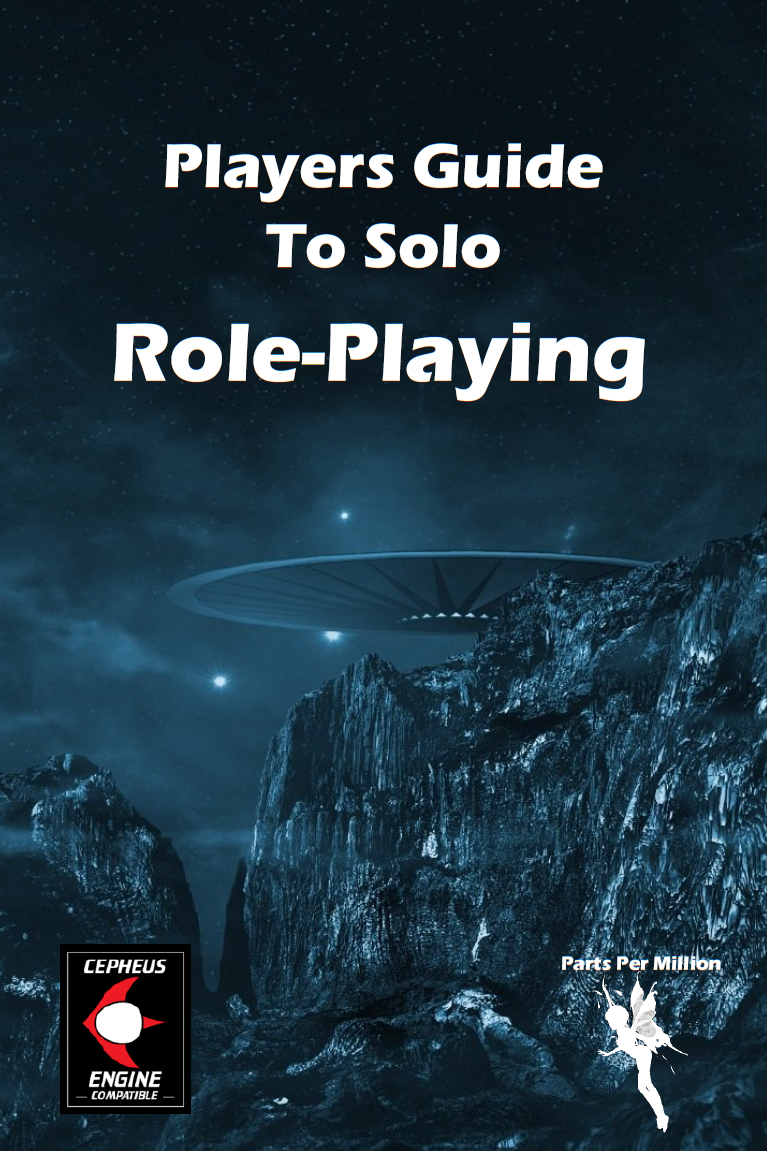Players Guide to Solo Roleplaying
This article originally appeared in the May/June 2021 issue.
 Players Guide to Solo Roleplaying.
Peter Rudin Burgess.
Players Guide to Solo Roleplaying.
Peter Rudin Burgess.
Parts Per Million Limited https://ppmgames.co.uk
42pp, PDF
US$4.95/UKú3.58
Traveller – and role-playing in general – has historically been very much a group activity. While material for handling solo play isn’t completely nonexistent, it is rare enough that ‘vanishingly’ isn’t an inappropriate modifier for ‘rare’. This volume is intended to provide a mechanism by which one can role-play without a group.
The introduction sets out the author’s goal for the volume, to present a set of rules for solo play that strike a reasonable balance between high creativity and improvisation vs. high mechanical randomization on one axis, and between rules-heavy and high-abstraction on the other axis. There is little discussion of why the extremes are considered undesirable; one might assume that the author sees the reasons as being self-evident.
Before actually getting started, the author provides definitions for terminology; even the experienced role-player would be well-advised to read through them, as some familiar terminology is used in ways that differ from ‘normal’ usage: for example, an ‘encounter’ in these rules refers to any situation or scene in which the character must make a meaningful choice, not just when the character meets a person or animal.
There is no description of character creation; the player is expected to use the standard character creation mechanism (in this case, Cepheus Engine, though the reality is that there isn’t anything in the rules that absolutely relies on any particular system or variation thereon). The author does note that the provisions for zero-level skills should be used in character generation.
A discussion of the structure of the solo adventure is included; it is important to realize that everything is structured around “encounters” as defined at the beginning.
While you do need a world for your solo adventure, you generate it “on the fly” as you need to. You do need to keep track of the facts about your world (and your character’s beliefs about it, which may not be the same); the author uses a “mind map” as the mechanism throughout the book – but you can and should use whatever best suits you. Rolling dice is kept to a reasonable minimum, and is almost invariably in response to a a question phrased so as to require a ‘yes/no’ type of answer. One exception is generating a ‘hook’ (the reason for the adventure); you are provided with a three-column ‘Chinese menu’ to roll on to generate inspiration, and then have to take the three words generated and decide what they mean. Of course, you don’t have to use the provided method; the idea is simply that you need to come up with a quick (ideally, one sentence) description of the purpose of the adventure you are about to set out on.
The descriptions of the process throughout your adventuring effort encourage a cinematic viewpoint: adventures, after all, are fundamentally dramatic, and it is ultimately the drama that draws you in and holds your attention. That you are choosing the direction of the action, and building the world and the adventure as you go along doesn’t change that; if anything, it emphasizes it.
The book wraps up with a strong recommendation that you keep a log of your adventure – it doesn’t matter what tool(s) you use, or the specific format of your notes; the idea is to keep the notes so that you can take a break and then pick up where you left off, and keep the logic of the adventure and the world consistent.
If you can run yourself through a few solo adventures and be happy with the results, you’ll find that you’re beginning to develop the skills you need to be a referee – because that’s really what you’re doing here; you’re not just a player in the solo adventure, you’re the referee.
If you’re interested in the refereeing side of things, this isn’t a bad tool to have in your toolkit (there’s material here that’s usable in party adventures, not just for solo play); if you’re only interested in the player’s side of the table, this may not be for you – it doesn’t hold your hand or provide any pre-generated scenes; rather, it tells you what you can do to build and adventure from scratch.
 Freelance
Traveller
Freelance
Traveller